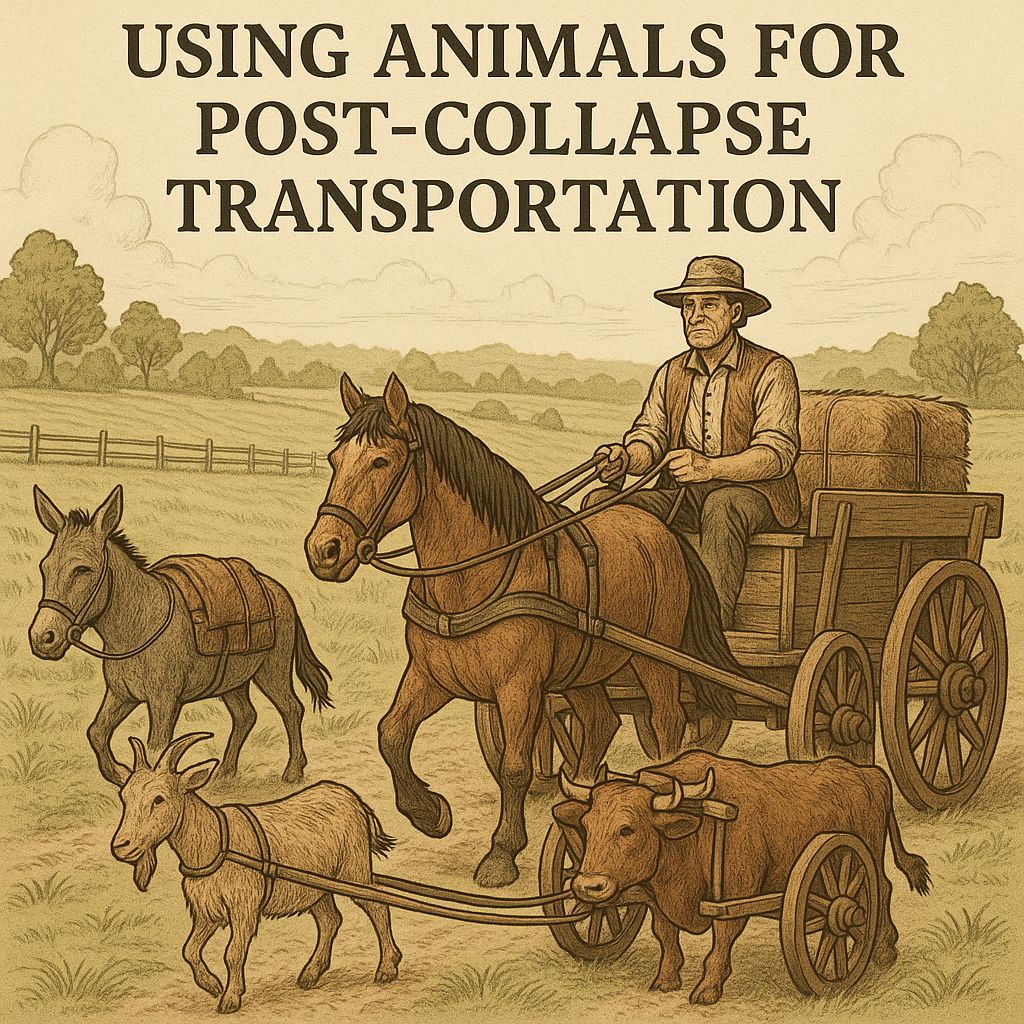When the fuel pumps run dry and modern logistics grind to a halt, the ability to move people and supplies without gasoline becomes critical. For preppers, mastering animal-powered transport isn’t nostalgia—it’s survival. Horses, donkeys, oxen, and even smaller draft animals like goats can become the lifeblood of mobility in a post-collapse world. But using animals for transportation requires forethought, land, and long-term commitment to feed production and husbandry.
🐎 Choosing the Right Animal
Each transport animal has strengths and trade-offs:
- Horses: Fast, versatile, and capable of covering 20–40 km per day with moderate loads. Require quality hay and grain, plus regular hoof care.
- Donkeys and Mules: Slower but hardier, need less feed and can thrive on rough forage. Ideal for rugged terrain and pack work.
- Oxen (trained cattle): Unmatched pulling power for wagons or plows. Thrive on pasture but require early training and yoke equipment.
- Goats or Dogs (small loads): Limited to light hauling—perfect for small carts, emergency stretcher rigs, or pack duties in mountainous areas.
Selecting the right animal depends on your region’s terrain, available feed, and your retreat’s overall agricultural setup.
🌾 Feed and Land Requirements
Animal transport ties directly to land management. Feed production can easily consume more acreage than the animals themselves occupy.
| Animal | Daily Feed (Dry Matter) | Annual Feed (Approx.) | Land Needed for Feed Production* |
|---|---|---|---|
| Horse (1,000 lb) | 15–25 lb hay + 5 lb grain | ~4 tons | 3–5 acres of hay land |
| Mule/Donkey | 10–15 lb rough forage | ~2 tons | 1–2 acres |
| Oxen pair | 40–50 lb hay | ~7 tons | 4–6 acres |
| Goat pair | 5–7 lb forage | ~0.75 ton | 0.5 acre (browse/pasture) |
*Assumes average yields in temperate Canada with rotational grazing and stored winter feed.
You’ll also need secure barns or lean-tos for winter shelter and an area for manure management—composting animal waste adds valuable fertility back to the fields.
🚜 Integrating Feed and Fodder Production
A balanced retreat plan dedicates part of your acreage to feed crops such as:
- Hayfields: Timothy, alfalfa, and clover—rotated every few years.
- Grain plots: Oats and barley for horses; corn for oxen.
- Root crops: Beets, turnips, or carrots for winter feeding.
- Pasture rotations: Dividing fields into smaller paddocks prevents overgrazing.
A general rule: one acre of good hayfield supports one large animal for 4–5 months of the year. You’ll need a year’s worth of stored hay before the first snowfall to ensure survival through winter.
🛠️ Training and Maintenance
Animal transportation isn’t as simple as hitching a wagon:
- Training: Start young. Horses and oxen need months of handling before they’ll reliably pull under harness.
- Shoeing and Hoof Care: A critical skill—hoof rot or stone bruises can immobilize your transport animal.
- Veterinary Basics: Learn to handle minor injuries, deworming, and parasite control yourself.
- Equipment: Saddles, bridles, harnesses, wagons, and sleds will require leather maintenance and spare parts.
Building a small blacksmith and tack repair workshop pays dividends when stores are gone.
🔄 Multi-Use Livestock
Transportation animals often play multiple roles in a prepper homestead:
- Oxen or horses can power mechanical equipment via belt drives.
- Donkeys can patrol fence lines or carry water from distant wells.
- Goats provide milk and clear brush while packing small loads.
Animals become renewable energy systems—biological “engines” that reproduce, self-repair, and yield secondary benefits like manure, milk, and companionship.
🧭 Strategic Considerations
- Breed for Resilience: Choose heritage or cold-hardy breeds adapted to your region.
- Fuel Independence: Each acre of hayfield offsets hundreds of litres of diesel annually.
- Security: Well-trained transport animals are valuable trade assets or barter items.
In a world where tires rot and roads crumble, animal-based transport ensures your community remains mobile, productive, and connected.
Book Recommendation:
📘 Acres of Preparedness: Planning the Last Safe Place
Learn how to design your self-reliant retreat—including livestock management, land allocation, and post-collapse logistics—from Canada’s leading prepper resource.


